Karl Shuker's Blog, page 34
October 30, 2015
MEET THE MONSTROUS MAKALALA - A TANZANIAN TERROR BIRD?
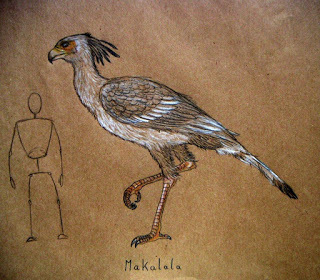 Reconstruction of the makalala's possible appearance in life (© Markus Bühler)
Reconstruction of the makalala's possible appearance in life (© Markus Bühler)Here's something suitable for Hallowe'en from the cryptozoological chronicles – a monster bird with a taste for flesh...human flesh.
No one doubts that the tallest species of bird alive today is Struthio camelus, the ostrich - no-one, that is, except for a mysterious tribe known as the Wasequa (mysterious because I have yet to uncover any information about them), who supposedly inhabit an unspecified region of Central Africa 8-9 days' journey from the coast of Zanzibar (presumably, therefore, somewhere within the territory of mainland Tanzania).
According to a report by a Count Marschall (Bulletin de la Société Philomatique, 1878-9), as recently as the 1870s these people averred that their territory harboured a monstrous bird even taller than the 8-ft-high ostrich, equipped with very long legs, the head and beak of a bird of prey (which it puts to good use when feeding on carrion from animal carcases), and the ability to take to the air in sustained, powerful flight. Also, each of its wingtips bears hard plates composed of a horny, compact substance, and when it strikes its wings together they produce a very loud noise, earning this bird its local name - makalala ('noisy').
The makalala is said by the Wasequas to be very fierce, but can be killed if the correct strategy is employed. Engaging upon an extremely hazardous version of 'playing possum', the would-be assassin has to lie on the ground and feign death, until the makalala approaches close enough to seize the supposed human carcase - whereupon the latter must reanimate himself instantly and deliver the fatal blow before the makalala can rectify its mistake!
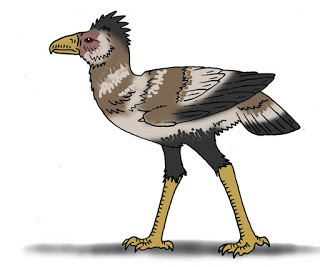 A second reconstruction of the makalala's possible appearance in life (© Tim Morris)
A second reconstruction of the makalala's possible appearance in life (© Tim Morris)So far, this could all be discounted as fanciful native folklore - but physical remains of the makalala may have been recorded too. Marschall mentioned a Dr Fischer, who saw in Zanzibar an object that he identified unhesitatingly as a rib from some form of gigantic bird. Narrowing from one end to the other, this alleged rib had a width of 8 in at its widest end, and was just under 1 in at its narrowest end. Unfortunately, Marschall did not record whether Fischer sent it to a scientific institution for conclusive identification and retention.
However, Marschall did record another possible source of makalala remains - because he noted that native chiefs placed makalala skulls on their heads, using them as helmets! Could any of these bizarre examples of protective headgear still be owned today by Wasequa tribesmen?
Assuming, against all the odds, that the makalala is real - that the frightening scenario of a carnivorous bird taller than the ostrich surviving into historical times on mainland East Africa somewhere near the island of Zanzibar is not a grotesque fantasy but a sober fact - what could it be? Several interesting, albeit mutually-exclusive lines of speculation compete for attention.
The first of these to be discussed here was kindly brought to my attention by German cryptozoologist Markus Bühler. Breeding throughout much of sub-Saharan Africa, sporting an immense wingspan of up to 10.5 ft (even greater spans have been claimed but presently not verified), standing up to 5 ft tall, and weighing as much as 20 lb, the well known marabou stork Leptoptilos crumenifer (syn. crumeniferus) is certainly an extremely impressive, potentially formidable bird. Indeed, when specimens are scavenging from a carcase, they will sometimes even ward off vultures once the latter birds of prey have torn chunks of flesh from the carcase with their hooked beaks (which marabous lack). Even so, it seems unlikely that such a familiar species could have somehow been converted by local myth and superstition into a mystery bird.
 The marabou stork (© DickDaniels/Wikipedia CC BY-SA 3.0 licence)
The marabou stork (© DickDaniels/Wikipedia CC BY-SA 3.0 licence)However, as Markus pointed out, during the Pliocene, Africa was also home to an even bigger species of marabou stork, L. falconeri, Falconer's marabou. Like L. crumenifer, it was widespread across northern and eastern Africa but stood around 6.5 ft tall (taller than an adult human of average height) and weighed up to 44 lb (as heavy as a small child). In comparison to L. crumenifer, Falconer's marabou exhibited a slight reduction in wing size, therefore possibly being more terrestrial than its modern-day relative, but it was still fully able to fly. As birds often look much bigger than they actually are, due to their plumage and pneumatic internal system adding substantial volume to their forms, this already-huge species would have been truly monstrous in appearance, added to which its possibly greater terrestrial lifestyle means that it may possibly have been able to kill and eat bigger creatures than L. crumenifer.
Based upon fossil evidence, Falconer's marabou stork had become extinct by the end of the Pliocene 2.5 million years ago, but if it had somehow survived into historical times (with what would be its more recent fossils not having been uncovered so far), there is no doubt that it could have been a thought-provoking makalala candidate (albeit one lacking the raptorial beak claimed by the Wasequas for the makalala). Even the latter's supposed wing-clapping sounds might in reality have been a confused memory of the beak-clapping sounds often produced by storks, and which would have been very loud if made by Falconer's marabou. However, there is currently no scientific evidence that the latter species did survive into historical times.
Another very large and intriguing species of bird that once inhabited Africa is Eremopezus eocaenus, which, as its name indicates, lived during the Eocene (specifically the late Eocene, between 36 and 33 million years ago). Its fossil remains, which have been obtained from Jebel Qatrani Formation deposits around the Qasr el Sagha escarpment, north of the Birket Qarun lake near Faiyum in Egypt, indicate that this was a very large, flightless, and quite possibly predatory bird, probably as tall as a small emu or large rhea but bulkier in form. Its taxonomic position has incited much debate, and it has yet to be confidently allied with any existing avian lineage, but the enigmatic Eremopezus does possess certain interesting and quite specific anatomical similarities with the secretary bird – a highly distinctive African species that will feature a little later in this discussion of potential makalala identities.
Could Eremopezus itself, however, be linked to the latter mystery bird? It seems implausible that this species could have lingered on into the present day or given rise to modern-day descendants without some geographically intervening remains have been found somewhere between Egypt and Tanzania's portion of East Africa. Then again, the fossil record is famously incomplete.
 Height comparison of Homo sapiens alongside a selection of terror bird species (from left to right) Kelenken guillermoi, Phorusrhacos longissimus, and Titanis walleri, plus the diatrymid Gastornis parisiensis (public domain)
Height comparison of Homo sapiens alongside a selection of terror bird species (from left to right) Kelenken guillermoi, Phorusrhacos longissimus, and Titanis walleri, plus the diatrymid Gastornis parisiensis (public domain)With flagrant disregard for zoogeographical dictates, the makalala readily recalls the phorusrhacids or terror birds. These were an aptly-named taxonomic group of huge flesh-eating birds known predominantly (but not exclusively) from the New World, and which attained their awesome zenith with a truly gigantic, spectacular species from Argentina's Patagonia region called Kelenken guillermoi.
Sporting a massive 28-inch-skull armed with an enormous hooked beak, this 10-12-ft-tall horror died out approximately 15 million years ago during the mid-Miocene, whereas Titanis walleri (originally thought to have been 10-12 ft tall too until further finds led it to be downsized to a still-daunting 5-6 ft) not only reached North America but lived there in Texas and Florida until as least as recently as 2.5 million years ago, making it the youngest terror bird species currently known. However, these fearful birds were flightless, as their wings were vestigial. Moreover, although confirmed terror bird fossils have been discovered in the Americas and also Antarctica, the only known fossil evidence for their erstwhile existence in Africa is a single femur from an individual that had lived during the early or early-to-mid-Eocene (i.e. between 52 million years and 46 million years ago) in what is today southwestern Algeria. In 2011, this mysterious species was named Lavocatavis africana.
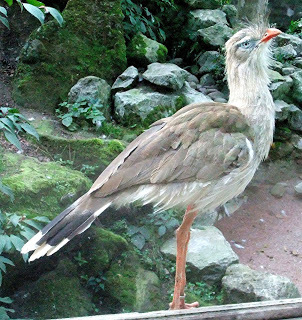 Red-legged seriema Cariama cristata (© Dr Karl Shuker)
Red-legged seriema Cariama cristata (© Dr Karl Shuker)Even so, could the makalala be an undiscovered modern-day species? There is one notable precedent for such speculation, because some zoologists consider it plausible that a living, flying species of phorusrhacid-related bird is already known from Africa – namely, that strange, stork-like bird of prey called the secretary bird Sagittarius serpentarius. Although it is commonly classed as an aberrant raptor, egg albumen comparisons suggest a closer taxonomic allegiance between this species and a pair of South American birds known as seriemas - which constitute the last surviving members of a phorusrhacid-allied taxonomic family.
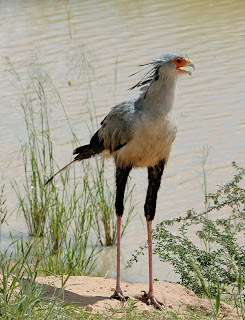 The secretary bird (© Brian Ralphs/Wikipedia CC BY 2.0 licence; photo cropped)
The secretary bird (© Brian Ralphs/Wikipedia CC BY 2.0 licence; photo cropped)Certainly, the secretary bird affords a compelling correspondence to the makalala's morphology (albeit on a rather more modest scale). Standing up to 4.5 ft tall on notably long, crane-like legs, and endowed with strong wings that support a powerful, soaring flight, plus the head and hooked beak of a bird of prey, the secretary bird constitutes a very acceptable makalala in miniature. Furthermore, when attacking snakes (an important part of its diet) it frequently shields itself from potentially fatal strikes with its outstretched wings, which are equipped with horny tips - i.e. claws on the tips of its 'finger bones' (phalanges), instantly recalling those of the makalala.
This last-mentioned correspondence is particularly telling, because there are very few species of bird alive today that are equipped with these wingtip claws. Indeed, other than the secretary bird, the only ones presently known are the three species of crane-allied birds called finfoots or sun-grebes, plus a vaguely grouse-like relative of waterfowl called the black-necked screamer Chauna chavaria - a South American speciality. In addition, a strange pheasant-like relative of cuckoos known as the hoatzin Opisthocomus hoazin, again from South America, produces curiously reptile-like offspring able to crawl along tree branches by virtue of two large, mobile claws on each wing, but these are lost as the chicks mature.
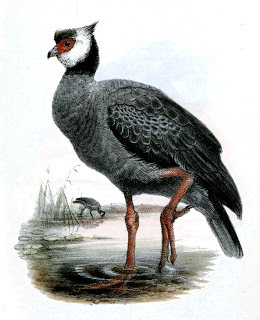 Illustration of the black-necked screamer, by Joseph Wolf, 1864 (public domain)
Illustration of the black-necked screamer, by Joseph Wolf, 1864 (public domain)Certain other birds, like the jacanas or lily-trotters, the spur-winged goose Plectropterus gambensis, the spur-winged plover Vanellus spinosus, and a pair of Antarctic endemics called sheathbills, possess horny spurs on their wings, used in combat - but these are variously sited on the 'wrist bones' (carpals) or 'hand bones' (metacarpals), not upon the finger tips.
Out of all of these species, moreover, only one - the secretary bird - is predominantly carnivorous. Could the makalala, therefore, be some form of extra-large secretary bird - not necessarily as tall as the Wasequas state (their fear of it could certainly have inflated their estimate of its height), but much bigger than today's single known species? If so, a suitable scientific name for it would be Megasagittarius clamosus - 'the noisy, giant secretary bird'.
Staying with the secretary bird line of speculation, is it conceivable, alternatively, that the makalala was a false secretary bird, i.e. some other raptorial species, possibly an accipitrid (the eagles, hawks, and Old World vultures), that had assumed via convergent evolution a form outwardly comparable to Sagittarius? Although this is just another suggestion with no tangible evidence to support it directly, there is actually an interesting confirmed precedent for such an ostensibly unlikely premise. In 1989, Drs Alan Feduccia and Michael R. Voorhies formally described a remarkable new species of North American fossil accipitrid from the late Miocene whose tarsometatarsal structure was nearly identical morphologically to that of the secretary bird. Indeed, the convergence was so striking that they christened this species Apatosagittarius terrenus, which translates as 'terrestrial false secretary bird', because they considered it likely that just like the true secretary bird, it had exhibited a predominantly terrestrial hunting lifestyle. In fact, it was only because the tarsometatarsus bore some attached phalanges (toe bones) whose structure was very different from those of the secretary bird that Feduccia and Voorhies were able to confirm that Apatosagittariuswas not a true secretary bird, but was merely an anatomical impersonator.
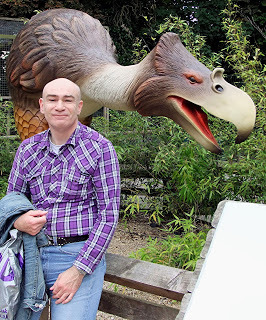 With a life-sized model of the North American terror bird Titanis walleri (© Dr Karl Shuker)
With a life-sized model of the North American terror bird Titanis walleri (© Dr Karl Shuker) All of the lines of speculation discussed above – with identity contenders ranging from marabou storks and terror birds to secretary birds, false secretary birds, and even the anomalous Eremopezus – are certainly absorbing and thought-provoking, but even if any of them is valid, it is scarcely likely to yield a living makalala, sadly. After all, a bird as large and as visually distinctive as this one would surely be hard-pressed indeed to remain undiscovered by science for long, regardless of the geographical locality involved - yet there do not appear to be any post-19th-Century reports of its existence. Thus, even if the makalala was a reality in the 1870s, presumably it no longer survives - but that does not mean that its former existence cannot be verified. As noted earlier, among the valued possessions and relics of present-day Wasequas there may still be one or more of the revered helmets worn by long-departed chiefs. Should one of these tribal heirlooms pass into the hands of an ornithologist, the lucky recipient could well find himself holding a bona fide makalala skull!
Having said that, I feel it necessary to insert a definite caveat lector here, because as the Wasequa tribe and their territory's precise location are no less elusive and enigmatic than the makalala itself, and as the same also appears to be true with regard to the Count Marschall whose letter seems to be the only original document recording this mystery bird, I cannot help but wonder whether the entire story is just that – a work of fiction, rather than a statement of fact. After all, let's be honest here, just how likely is a still-undiscovered species of carnivorous flying bird taller than an ostrich, even in the least-explored corners of East Africa?
The above ShukerNature blog article is excerpted from my long-awaited updated edition of In Search of Prehistoric Survivors – coming soon…
And staying with monstrous birds, be sure to click here to read my ShukerNature article about the seriously scary giant marabou 'stork of doom' pictured below that was still alive in southeast Asia as recently as the late Pleistocene, approximately 18,000 years ago.
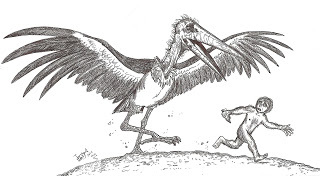 Leptoptilos robustus
, the spectacular if flightless giant marabou stork of Flores, and one of the diminutive real-life hobbits (Flores Man Homo floresiensis) that lived in its formidable shadow (© Hodari Nundu)
Leptoptilos robustus
, the spectacular if flightless giant marabou stork of Flores, and one of the diminutive real-life hobbits (Flores Man Homo floresiensis) that lived in its formidable shadow (© Hodari Nundu)For a comprehensive coverage of the terror birds' evolution and fossil history, check out my book The Menagerie of Marvels , which features on its front and back covers a spectacular pair of terror birds depicted by acclaimed artist Anthony Wallis – thanks Ant!
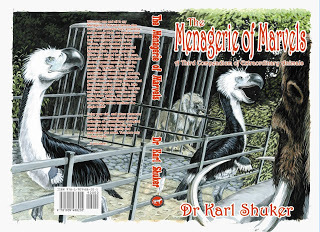
Published on October 30, 2015 22:58
October 28, 2015
HORNING IN ON THE UNICORN SNAKE
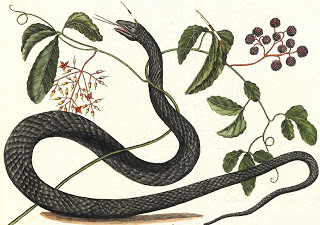 Hoax unicorn snake - photo-manipulation to demonstrate what such an exhibit would have looked like (© Dr Karl Shuker)
Hoax unicorn snake - photo-manipulation to demonstrate what such an exhibit would have looked like (© Dr Karl Shuker)During the Middle Ages and even several centuries later, explorers and travellers to exotic far-flung localities around the globe would often return home to Europe with unusual animal specimens as interesting souvenirs. Sadly, however, some of these items were outright fakes (such as the infamous 'Feejee mermaids', which were composite creations deftly manufactured from preserved monkeys and large fishes) or deliberately misidentified objects (such as ibex or antelope horns masquerading as griffin or dragon claws) that had been sold to the unsuspecting voyagers at exorbitant prices by unscrupulous vendors.
An ophidian representative from these shaming cabinets of credulities was the unicorn snake. Generally procured in the East, this usually took the form of a dried, preserved serpent of fairly sizeable proportions but sporting as its most eyecatching characteristic a long spine protruding from the centre of its brow like a veritable herpetological unicorn.
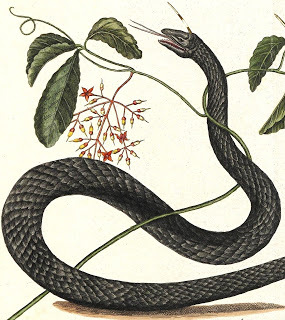 Photo-manipulation close-up demonstrating what a hoax unicorn snake created using an inserted cut-down porcupine quill would have looked like (© Dr Karl Shuker)
Photo-manipulation close-up demonstrating what a hoax unicorn snake created using an inserted cut-down porcupine quill would have looked like (© Dr Karl Shuker) Needless to say, however, an examination of such a specimen by an experienced naturalist invariably revealed that its 'horn' was merely a cut-down quill from a porcupine or a spine from a hedgehog or spiny-finned fish that had been carefully inserted and glued inside the serpent's head. I have also read of living specimens of supposed unicorn snakes, though I can't imagine that any snake would live very long if they had been subjected to such a barbaric treatment, because the inserted quill or spine would probably pierce their brain.
Worth noting is that there is a real species of snake that is sometimes dubbed the green unicorn. More commonly termed the rhinoceros rat snake Rhynchophis boulengeri, however, this green-scaled non-venomous colubrid from Vietnam and China earns its rhino and unicorn epithets from the very prominent, pointed, scaly protrusion borne upon the front of its snout like a small horn.
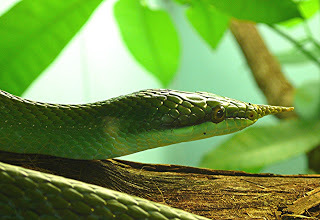 Head of a rhinoceros rat snake, showing its distinctive snout-horn (public domain)
Head of a rhinoceros rat snake, showing its distinctive snout-horn (public domain)
Published on October 28, 2015 16:25
October 18, 2015
WALT DISNEY AND THE BLACK PUMA THAT NEVER WAS
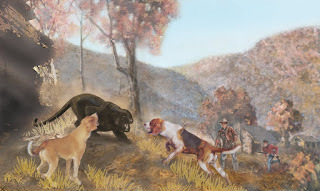 What are North America's mystery black panthers – escapee/released melanistic leopards, or native all-black pumas? (© William Rebsamen)
What are North America's mystery black panthers – escapee/released melanistic leopards, or native all-black pumas? (© William Rebsamen)Time to debunk another crypto-controversy, though in this case it's not a deliberate hoax, merely a mixture of confusion and absence of the required facts.
As I have documented elsewhere on ShukerNature (click here ), physical evidence for the reality of melanistic (all-black) pumas Puma concolor (aka cougars, mountain lions, painters, etc) in North America is conspicuous only by its absence. Certainly, large black cats often nicknamed panthers or black panthers (names more correctly applied to melanistic specimens of the leopard Panthera pardus) have been frequently reported from many parts of the United States and Canada too, but none has ever been made available for scientific examination resulting in a confirmed identification (even outside North America, I only know of two dorsally black, ventrally paler pumas – one shot in Costa Rica, the other in Brazil). So what do we have in the following video clip?
Several times lately, correspondents have drawn my attention to a certain brief clip of film, which keeps appearing, disappearing, and reappearing on YouTube. It's back again at present, so view while you can here . Judging from the comments present beneath it on YouTube, viewers seem to think shows a genuine film of a genuine black puma attacking and killing a dog. The reality is very different.
This is not a genuine black puma, it is simply a normal one that has been dyed black in order to resemble North America's elusive mystery black panthers of cryptozoological acclaim. Nor is this a real, non-fiction video either – it is merely a clip from the 1977 'Wonderful World of Disney' television movie entitled The Ghost of Cypress Swamp, starring Jeff East and Vic Morrow.
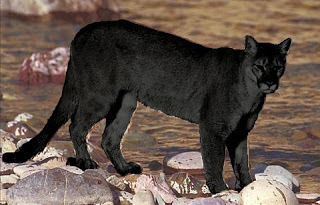 A computer-generated image of what a melanistic puma may look like (© Dr Karl Shuker)
A computer-generated image of what a melanistic puma may look like (© Dr Karl Shuker)As a massive life-long Disney fan, I used to watch this series avidly as a youngster, as well as its equally excellent predecessor, 'Walt Disney's Wonderful World of Color', and as you'd expect, I can still remember seeing the black puma clips from this particular movie, though I have to confess that the rest of it is somewhat of a haze now, almost 40 years later. Curiously, although shown in England, it has apparently never been released in the USA, its unfamiliarity therefore possibly helping to explain why clips from it featuring the cosmetically-created black puma have been mistakenly assumed by some online viewers to depict real scenes featuring a real black puma.
The whole movie can be viewed on YouTube here , with the clip in question beginning at 1.25:10 and continuing (with a brief break during which the dog's owner goes home to get his gun) for the next couple of minutes before the dog is rescued alive and well by its owner. This is, after all, a Disney family movie, so naturally all ends well for the dog. As for its general storyline, here is the plot synopsis accompanying it on YouTube: "Set in swamplands in Georgia his dog is attacked by a panther called Weakfoot. Later he [Jeff East's character] is captured by a wild man living in the swamps and believed to be dead".
As kindly brought to my attention recently by one of my correspondents, in a few clips in this film the black dye has seemingly rubbed off (or not fully taken on) parts of the puma's face, especially around the eyes, and on the mouth and nose (most noticeably at 15:41), revealing its normal paler fur. In any case, if this cat had truly been a black puma, it would have been so valuable and rare that it would have been one of the biggest, most famous stars in Hollywood in its own right, as famous as Lassie and Rin Tin Tin.
So, as film cops always say at the denouement of a crime case, move on people, nothing to see here.
Further information concerning the likelihood (or otherwise) of black pumas existing can also be found in my two books on mystery cats – Mystery Cats of the World (1989) and Cats of Magic, Mythology, and Mystery (2012).

Published on October 18, 2015 10:44
October 11, 2015
DEEPLY DIPPY OVER DIPLOCAULUS
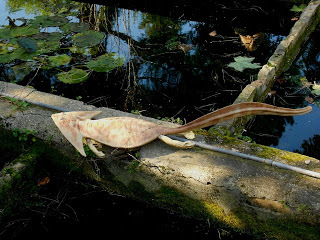 Traditional boomerang-headed restoration of Diplocaulus (public domain)
Traditional boomerang-headed restoration of Diplocaulus (public domain)Up to 3 ft long, superficially salamander-like in basic form, and belonging to the long-extinct nectridean taxonomic order within the equally erstwhile subclass of archaic amphibians known as lepospondyls, one of my favourite creatures from pre-dinosaurian prehistory has always been Diplocaulus– famous for its huge inverted V-shaped or boomerang-shaped head, as exhibited by several species (plus a very close relative, the lesser-known but near-identical Diploceratus burkei). The reason for its head's bizarre shape is its skull's pair of enormous but dorsoventrally flat, lateral bony projections known as tabular horns. These remarkable structures may have enabled its head to serve as a hydrofoil when this amphibian was swimming, or may even have prevented it from being swallowed by predators, by increasing its head's width beyond the gape of any carnivorous creature alive at that time that shared its zoogeographical distribution range.
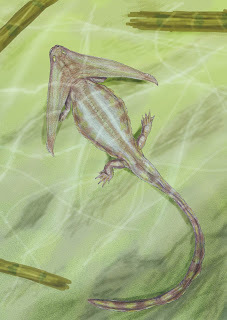 Restoration of Diploceraspis burkei (© Dmitry Bogdanov/Wikipedia CC BY 3.0)
Restoration of Diploceraspis burkei (© Dmitry Bogdanov/Wikipedia CC BY 3.0)Arising in North America, this extraordinary creature lived during the Permian Period (approximately 300-250 million years ago), although only D. minimus, currently the only known non-American representative (native to Morocco), occurred during the late Permian. Consequently, this makes various photographs and videos of alleged living Diplocaulus specimens that have surfaced online and elsewhere in the media during recent years nothing if not intriguing…
DIPLOCAULUS IN A DISH (DIAD)
The first of these reputed resurrectées is one that I shall refer to hereafter as DIAD (short for Diplocaulusin a dish). As I documented in my book Extraordinary Animals Revisited (2007), in September 2004 Fortean Times forwarded to me a short note from reader Stuart Pike enquiring about a photograph that had been circulating online and which depicted a bizarre-looking mystery beast labelled in accompanying internet reports as a hammerhead lizard. Here is the photograph in question:
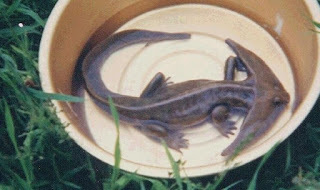 The 'hammerhead lizard', or, as I have since dubbed it, the DIAD (© source unknown to me)
The 'hammerhead lizard', or, as I have since dubbed it, the DIAD (© source unknown to me)Not long afterwards, Maltese journalist Tonio Galea independently contacted me, requesting details about this same photo (still of unknown origin), whose creature, according to local Maltese rumour, had lately been discovered alive on a rocky beach at Il-Maghluq, Marsascala, in the south of the island. I subsequently received several more enquiries from other correspondents, and so too, it transpired, did various other scientists, including Malta University biologist Prof. Patrick J. Schembri, who wrote about it in a letter published on 21 November 2004 in Malta's Sunday Times newspaper (click here ).
In reality, however, what this intriguing photo depicts is a gypsum/non-urethane foam-based model of a Diplocaulus. Investigations of mine eventually revealed via a Japanese model-making website (click here ) that this DIAD had been manufactured back in 1992 by an amateur Japanese model maker in response to a magazine competition. I have still not succeeded in discovering the model maker's name, but I did manage to uncover a second photograph of the DIAD itself, which is this one:
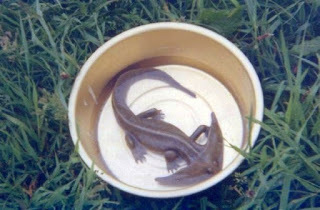 Second photograph of the DIAD (© source unknown to me)
Second photograph of the DIAD (© source unknown to me)DIPLOCAULUS ON VIDEO
YouTube contains several videos purporting to show living specimens of Diplocaulus (with at least two totally different specimens featured – one pink, one green), but all of them have been filmed and uploaded by the same person – which means that either he/she is unaccountably successful at locating living specimens of an amphibian deemed extinct for at least 250 million years by palaeontologists; or, all is not as it seems.
The person in question has the YouTube username SouldierTVSP, and has loaded three separate videos of what is claimed to be the same specimen, which can be viewed in sequence of their filming here , here , and here ; plus a much shorter video montage here ; and a video of a visibly different specimen here .
The first of the three videos allegedly showing the same specimen was filmed on 22 July 2011 (according to an on-screen caption). The second video consisted of three separate segments, filmed respectively (according to on-screen captions) on 26 July 2011, 1 August 2011, and 8 August 2011. No on-screen date was given for the third video, but as all three videos were uploaded by SouldierTVSP on 8 August 2011, this third video was clearly a continuation of the second one's ending section. Each of the three videos was accompanied by the following interestingly worded request: "Someone, please teach me this strange creature's true colors", beneath which for the third video was this additional, rather more forthright statement: "Diplocaulus Still Alive!! Paranormal Creature".
As will be seen when viewed, these three videos show what looks like a pink toy Diplocaulus amidst some vegetation debris floating in a current of water, seemingly a stream or river. There is nothing in the videos that can be used as an effective up-close scale to provide an estimate of size for the object (but unless the surrounding debris is very substantial, it would seem to be small). The object is moving entirely passively, drifting and buffeted by the current, with just an occasional slight movement of its tail or head, as might be expected, for instance, of a toy with a jointed tail and head, but no sign of any independent animate movements. In contrast, palaeontologists believe that in life, Diplocauluswould have probably swum by vertical undulations of its body, as its small weak legs and relatively short tail would not have been of much locomotory assistance. Of course, the object in the videos just might be a recently dead animal as opposed to a living one, but to my eyes the object looks as if it has never lived. Also, these three videos were filmed over an 18-day period, and yet the object's appearance does not change at all (in 18 days, a dead animal, conversely, would have shown considerable signs of decomposition, assuming that it hadn't already been devoured by a predator).
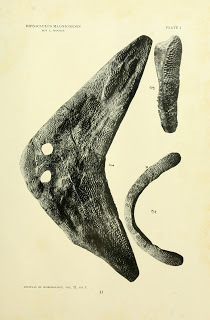 Diplocaulus
magnicornis,fossil skull, in Journal of Morphology, 1912 (public domain)
Diplocaulus
magnicornis,fossil skull, in Journal of Morphology, 1912 (public domain)On 16 November 2012, SouldierTVSP uploaded a very short video montage entitled 'Diplocaulus Still Alive! Cryptid Exist [sic]'. It began with a brief clip of a still photograph depicting someone holding a large creature to the camera, its somewhat salamander-like head pointing forward as it looks directly into the camera. The head bears a pair of fleshy flap-like lateral projections, but these are nowhere near as large or boomerang-shaped as those of Diplocaulus. The rest of the creature cannot be readily seen; indeed, based upon that photo alone, I'm not entirely convinced that the creature is an amphibian (not even a deformed one), rather than some unusual wide-mouthed fish. Nevertheless, an on-screen caption states in English and Japanese states that as soon as its identity as Diplocaulus is confirmed, the full footage will be released (but as far as I'm aware, no such release has occurred so far). The remainder of the video shows what seems to be the earlier pink apparent toy Diplocaulus resting on some vegetation (with a live wild duck of similar size close by, thus providing a useful size scale), then ending with a four-second clip of what looks like this same object floating in the water with its tail swishing from side to side, but very plausibly caused simply by the water current moving a jointed tail on a toy.
The final alleged Diplocaulus video by SouldierTVSP, uploaded on 11 January 2012, has the somewhat unpromising title of 'Kinky Cryptid Sightings', and showcases an iridescent green Diplocaulus with an enormous head moving across a pond (located near a waterfall) at the water surface in a seemingly active manner before its huge boomerang-shaped head becomes entangled in what looks worryingly like an item of female undergarment floating there (which presumably explains the title of the video!). For these reasons alone (not to mention the wide variety of anything-but-serious videos on other cryptozoological subjects that this person has also uploaded onto YouTube), I personally find it difficult to take this video seriously. In my view, some form of self-propelled model has been filmed here – but I would love to be proved wrong!
OH, DIPLOCAULUS, WHAT CAN THE MATAMATA BE?
On 10 October 2015, the following photograph was tweeted to me by The Anomalist @anomalistnews, stating: "Is this a better diplocaulus hoax, or a previously unknown animal?" and "Only details on this photo is it was taken in "Asia" and was posted on Facebook".
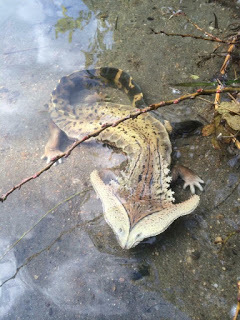 Online photograph tweeted to me of an unequivocally Diplocaulus-like creature – but was it alive? (see later in this ShukerNature article for subsequently-discovered copyright credit)
Online photograph tweeted to me of an unequivocally Diplocaulus-like creature – but was it alive? (see later in this ShukerNature article for subsequently-discovered copyright credit)Needless to say, it certainly looked like a Diplocaulus, no question about that, and the degree of morphological detail visible in the photograph was extensive – but was it a living animal, or was it either a very realistic model or a very skilfully photo-manipulated image?
Not surprisingly, this mystery photograph attracted considerable interest and comments on Twitter, including this thought-provoking suggestion by Facebook friend Paul Willison: "IMO, a photoshop of a hellbender or giant salamander and baby mata mata turtle", who also attached some photographs of these species in support of his opinion.
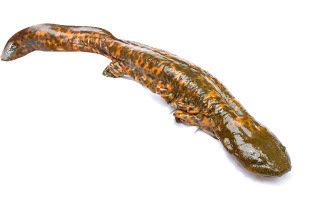 A hellbender (© Brian Gratwicke/Wikipedia CC BY 2.0)
A hellbender (© Brian Gratwicke/Wikipedia CC BY 2.0)The hellbender Cryptobranchus alleganiensis is North America's giant salamander, beaten in size only by the giant salamanders of China and Japan; and the mata mata or matamata Chelus fimbriata is a very bizarre-looking species of South American freshwater turtle.
And there is no doubt that the ostensible Diplocaulus in the mystery photo does embody features from both of these species, so could that be the answer – a photographic montage or composite created by some ingenious morphing of matamata and hellbender images by person(s) unknown?
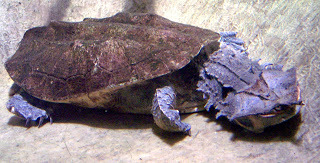 A matamata (© Stahlkocher/Wikipedia CC BY-SA 3.0)
A matamata (© Stahlkocher/Wikipedia CC BY-SA 3.0)Spurred on by Paul's suggestion, I spent some time Google-imaging matamata turtles, hellbenders, and giant salamanders in general, in search of corresponding photos or portions of photos, as well as Diplocaulus, in search of matching photos of models and restorations – but nothing turned up, until…
After scrolling down to the very bottom of the umpteenth Google-image search page using the above and similar animal names as search words, suddenly the mystery photograph itself appeared!
It proved to be a photo of an exceedingly life-like Diplocaulus model created by expert Japanese model maker Goro Furuta. What's more, it was just one of several photos (all copyrighted to Goro) of this wonderful model that were present in a publicly-viewable album on Goro's Facebook page. This album can be viewed here , and includes the following close-up photo of the model resting on someone's hand and arm:
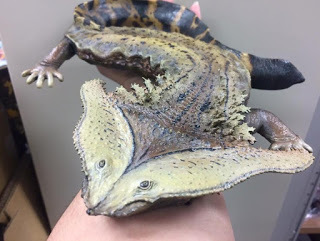 Second photograph of Goro Furuta's excellent Diplocaulus model (© Goro Furuta)
Second photograph of Goro Furuta's excellent Diplocaulus model (© Goro Furuta)Goro has prepared many additional, equally spectacular animal models, and as I swiftly became a massive fan of his work after browsing pictures of them in his several albums on Facebook depicting his work, I am delighted that he is now a Facebook friend of mine.
Incidentally, I'd like to stress here that at no point has Goro ever claimed or sought to suggest that his Diplocaulus model was anything other than a model - the online confusion as to whether or not the photograph of it currently doing the internet rounds portrayed a living Diplocaulus is due entirely to misinformed speculation by people seeing the photo (copied from Goro's FB album and circulated online by person/s unknown) but not knowing its origin and incorrectly assuming the model to be a real animal. (Having said that, I suppose it can be viewed as a backhanded compliment to Goro's model-making expertise that his Diplocaulus model is so realistic that people have assumed that it was a living creature!)
The mystery of the most life-like non-living Diplocaulus reported online so far was a mystery no longer. In a tweet of 10 October 2015 replying to the original one by The Anomalist and to those of Paul Willison, I stated: "It's a Diplocaulus model, by Japanese model-maker Goro Furuta: [and then I included the link to Goro's relevant Facebook album]".
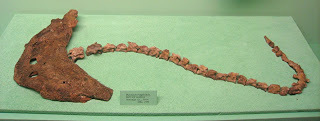 Skull and vertebrae of Diplocaulus magnicornis unearthed in Willbarger County, Texas; displayed at the University of Michigan's Natural History Museum (public domain)
Skull and vertebrae of Diplocaulus magnicornis unearthed in Willbarger County, Texas; displayed at the University of Michigan's Natural History Museum (public domain)Sadly, however, it means that this boomerang-headed amphibian remains interred within the long-vanished Permian Period, but even back there it has offered up a startling surprise. Trace fossils have been found showing a pair of flaps or membranes linking the tips of its head's tabular horns to its body – in other words, Diplocaulusmay not have been outwardly boomerang-headed as traditionally assumed, but might well instead have resembled in life the restoration depicted at the end of this ShukerNature blog article, on display at the University of Michigan's Natural History Museum.
If so, then any videos or future photos of purported living Diplocaulus specimens that possess a boomerang-shaped head can swiftly be discounted (always assuming, of course, that an evolved modern-day Diplocaulus did not develop one during its 250-million-year continued evolution since the Permian?).
For now, however, all of this is academic, because Diplocaulus is still defunct, but it is remains one of my favourite prehistoric creatures too – even if it has lost its boomerang!
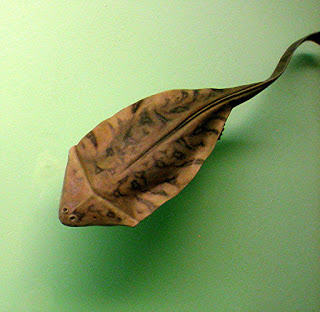 Modern reconstruction of Diplocaulus magnicornis, exhibiting membranes enclosing its tabular horns; displayed at the University of Michigan's Natural History Museum (public domain)
Modern reconstruction of Diplocaulus magnicornis, exhibiting membranes enclosing its tabular horns; displayed at the University of Michigan's Natural History Museum (public domain)
Published on October 11, 2015 17:14
October 6, 2015
A NEW ZEALAND MOA IN CAMBODIA?
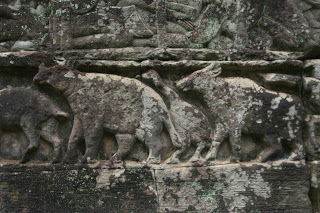 Bayon glyph depicting mystery long-necked bird between rhinoceros and ox at Angkor Wat, Cambodia (public domain)
Bayon glyph depicting mystery long-necked bird between rhinoceros and ox at Angkor Wat, Cambodia (public domain)They say that beauty is in the eye of the beholder, and the same has certainly been true of cryptids on many occasions in the past. The following case may – or may not – constitute a further example of this cryptozoological rule of thumb.
In terms of their current native zoogeography, modern-day ratites all have very precise distributions on the continental level. The ostrich is nowadays entirely confined to Africa (its contingent in Asia Minor was hunted into extinction by the mid-20th Century), the rheas to South America, the emu to Australia, the now-extinct moas to New Zealand, the now-extinct elephant birds to Madagascar, and the cassowaries to Australia and New Guinea. However, there are no known modern-day ratites native to mainland Asia (nor are there any to Europe or North America either, for that matter), which makes a certain enigmatic carving present on a famous Indochinese temple of particular interest.
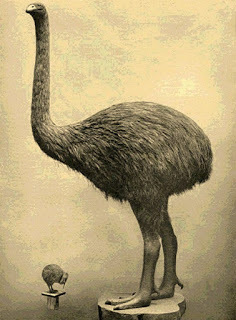 Vintage illustration of a giant moa Dinornis sp. alongside a kiwi (public domain)
Vintage illustration of a giant moa Dinornis sp. alongside a kiwi (public domain)Dating from the 12thCentury and richly decorated with countless numbers of bas-relief glyphs carved upon its numerous sandstone columns and walls, depicting a wide range of deities and animals, Angkor Wat is a celebrated temple complex in Cambodia and constitutes the world's largest religious monument. It also lays claim to cryptozoological fame, courtesy of a specific glyph carved on a wall at Ta Prohm, one of the temples in this complex, because the animal portrayed by this glyph bears a remarkable superficial resemblance to one of the classic plate-backed stegosaurian dinosaurs from prehistoric times. Not surprisingly, this anomalous, ostensibly anachronistic carving has attracted considerable discussion and dissension as to what creature it does truly depict, and I have documented it in a number of my own publications.
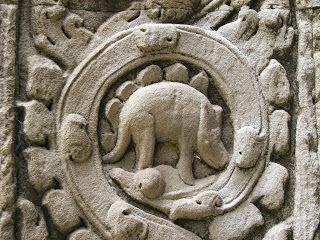 Angkor Wat's 'stegosaur' glyph (© Jon and Leslie Burke)
Angkor Wat's 'stegosaur' glyph (© Jon and Leslie Burke)However, there is also a second glyph at Angkor Wat that, although far less famous than the 'stegosaur', is no less intriguing from a cryptozoological viewpoint, because one identity scientifically proposed for the notably long-necked bird that it depicts is a New Zealand moa. This glyph can be found in a temple known as the Bayon, with the mystery bird in question being sandwiched between a carving of a rhinoceros to its immediate left and one of an ox (possibly a gaur) to its immediate right.
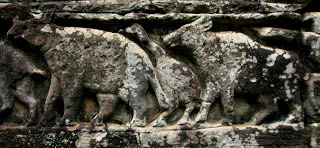 Close-up of Bayon glyph depicting rhinoceros, mystery long-necked bird, and ox at Angkor Wat, Cambodia (public domain)
Close-up of Bayon glyph depicting rhinoceros, mystery long-necked bird, and ox at Angkor Wat, Cambodia (public domain)As seen in the illustration reproduced here of this glyph's animal trio, the bird has stout legs, a noticeably plump winged body, and an extremely long slender neck with a small head atop. In the April 1986 issue of the German scientific periodical Natur und Museum, Drs G.H. Ralph von Koenigswald and Joachim Steinbacher correctly pointed out that the above morphology ruled out any of the local heron species (the same is true of storks, because both storks and herons possess very long, slender, bayonet-like beaks, whereas the carved bird's is shorter, stouter, and has a hooked tip). They also noted that the glyph carver's placing it between two such large mammals as a rhinoceros and an ox (and with its head almost as high as theirs despite the fact that its neck was not even upright but was being held at an angle of approximately 45°) was probably done specifically to demonstrate just how big this bird was.
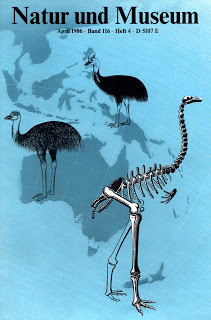 April 1986 issue of Natur und Museum, featuring on its cover the avian subjects in the von Koenigswald-Steinbacher paper (© Natur und Museum)
April 1986 issue of Natur und Museum, featuring on its cover the avian subjects in the von Koenigswald-Steinbacher paper (© Natur und Museum)Reflecting upon these factors, the authors suggested that perhaps the bird was a New Zealand moa, and, if so, quite probably the sturdy, relatively short-legged coastal moa Euryapteryx curtus (as opposed to the more famous and taller but much slimmer and longer-legged giant Dinornis moas). The moas were not believed to have become extinct in their native New Zealand domain until the mid-1400s (seemingly as a result of over-hunting and habitat destruction by the Maoris), i.e. around 250 years after the creation of Angkor Wat. Due to the extensive trade links and maritime travel that had been occurring in the southeast Asian-Australasian region for many centuries, the authors believed it likely that New Zealand's mighty moas would have been known about in Indochina at the time of Angkor Wat's creation, and that their spectacular appearance might well have inspired a carving of one to be produced amid the many other depictions of striking wildlife and mythological monsters present here.
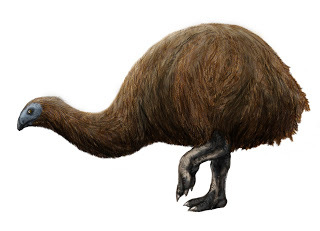 Restoration of Euryapteryx(© FunkMonk/Wikipedia CC BY-SA 3.0)
Restoration of Euryapteryx(© FunkMonk/Wikipedia CC BY-SA 3.0)Moreover, as the authors also noted, traders throughout history have transported preserved and living specimens of unusual, exotic-looking animals far from their native homelands to those of the traders as curiosities for exhibition purposes. Hence it is remotely possible that merchants travelling between Australasia and Indochina brought a preserved or perhaps even a living moa back with them to Cambodia at some point during the quarter-millennium spanning Angkor Wat's completion and the moas' extinction in New Zealand.
 Alongside a life-sized statue of a sturdy moa in Auckland, New Zealand (© Dr Karl Shuker)
Alongside a life-sized statue of a sturdy moa in Auckland, New Zealand (© Dr Karl Shuker)And indeed, there are some very pertinent precedents for transporting living ratites from Australasia to Asia, because cassowaries are known to have been transported westwards by mariners in bygone centuries from their native Australian and New Guinea homelands to Indonesia and China. Indeed, as the authors also discussed in this same paper, there is even a glyph of a cassowary-like bird at the Tjandi-Panataran, a Hindu temple not far from Wadjak in Java and dating from around the 12th-15th Century, which may offer further evidence of such transportations. Additional details regarding this subject are contained in my book The Beasts That Hide From Man (2003) and also in a ShukerNature blog article on cassowaries (click here ).
 Glyph of cassowary-like bird at Java's Tjandi-Panataran temple (public domain)
Glyph of cassowary-like bird at Java's Tjandi-Panataran temple (public domain)Having said that, there might be an altogether much more mundane, prosaic explanation for the long-necked mystery bird of Angkor Wat. Namely, that its appearance may not be due so much to any taxonomic identity as a moa but rather to the fact that there was a space needing to be filled between the rhino and the ox, and a non-specific long-necked bird simply made an ideal space-filler, with any perceived similarities to Euryapteryx or any other moa being merely coincidental. In short, the bird's morphology was moulded by the specific shape of the space needing to be filled, nothing more.
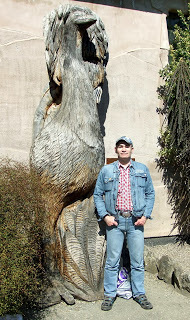 Alongside a life-sized statue of a giant moa Dinornis sp. at Chester Zoo, England (© Dr Karl Shuker)
Alongside a life-sized statue of a giant moa Dinornis sp. at Chester Zoo, England (© Dr Karl Shuker)Indeed, a telling suggestion that this may well be the case is that whereas the wings of all moas were non-existent, the Angkor Wat bird has a very large, conspicuous wing readily visible. In addition, moa beaks were not hook-tipped. Such notable discrepancies as these would not be expected if the glyph provides as accurate a representation of the bird as it does for the rhinoceros and the ox, both of which are portrayed realistically and are readily recognisable.
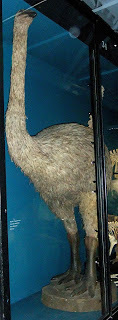 Life-sized restoration of Dinornis moa at Tring Natural History Museum (© Dr Karl Shuker)
Life-sized restoration of Dinornis moa at Tring Natural History Museum (© Dr Karl Shuker)This ShukerNature blog article is excerpted from my latest book, A Manifestation of Monsters .
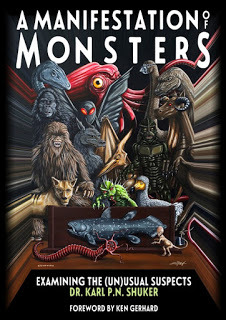
Published on October 06, 2015 04:03
September 23, 2015
IN TUNE WITH NESSIE - A SELECTION OF LOCH NESS MONSTER-THEMED SONGS
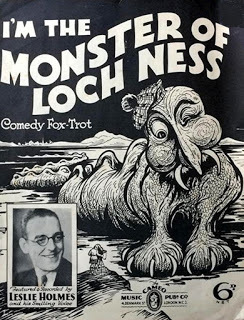 Sheet music for 'I'm the Monster of Loch Ness', a 1934 song made famous by British variety star Leslie Holmes (public domain/supplied by Joe Mancini)
Sheet music for 'I'm the Monster of Loch Ness', a 1934 song made famous by British variety star Leslie Holmes (public domain/supplied by Joe Mancini)It will probably come as no surprise to discover that such an iconic figure as Nessie the Loch Ness monster (LNM) has been celebrated and immortalised by music down through the decades since her modern-day media debut during the early 1930s, but what may be surprising is the wide range of genres that have done so - from foxtrots and folk to heavy metal, skinhead reggae, and cartoon classics. So here is an annotated listing of some famous and not-so-famous musical tributes to the world's favourite monster, whatever your tuneful tastes may be, and accompanied wherever possible with links to their performances on YouTube.
And where better to begin than with some wonderful recordings inspired by and released during that fateful 1933-1934 period of LNM-related frenzy, a period that witnessed the reporting of some classic Nessie sightings following the recent opening of the road around the loch – a significant event that had brought the alleged existence of Nessie to the attention of an entranced media, both nationally and internationally.
Leslie Holmes (1934). 'I'm the Monster of Loch Ness'.
Perhaps the most famous of these early 1930s Nessie recordings is this delightful ditty, a comedy foxtrot sung by popular British variety star Leslie 'the smiling vocalist' Holmes. Recorded on 6 January 1934 as a 78 rpm shellac record by London's Regal Zonophone label (with sheet music published by Cameo Music), it also featured the Midnight Minstrels, plus Scott Wood and His Orchestra. Holmes was also filmed singing it, in b/w, by London's British Pathé Studio, in an amusing sketch that included an appearance by Nessie herself at its close. Recorded on 25 January 1934, this sketch can be viewed here on YouTube.
 Leslie Holmes (public domain)
Leslie Holmes (public domain)In 2014, M. Ryan Taylor brought out a book of spooky songs entitled The Haunted Ukelele, which included 'I'm the Monster of Loch Ness'. Here is a recording of him singing it while playing a Koa model Godin Multiuke.
My sincere thanks to Facebook friend Joe Mancini for first alerting me to the Leslie Holmes version of this song.
Brian Lawrance (1934). 'Boo, Boo. Here Comes the Loch Ness Monster'.This song is much more obscure than the previous one, despite featuring the well-regarded British vocalist and band leader Brian Lawrance on its best known version, which again was recorded in January 1934 as a 78 rpm record, but this time by the Eclipse label. As yet, I have been unable to trace an online version of it.
John Tilley (1933). 'The Loch Ness Monster'.Not a song as such but what was back then a very famous comedy monologue for radio, spoken by John Tilley, a briefly popular, quintessentially English broadcaster/revue artist during the early 1930s, who recorded it as a 78 rpm record in December 1933 for the Columbia label. Tragically, Tilley was only in his late 30s when he died in 1935. You can listen to it here .
After those early recordings, a fair few years went by before Nessie received much in the way of further musical mileage, but from the 1960s (and especially the 1970s) onwards, she has been a perennially popular subject for songs and melody, as the following diverse selection demonstrates.
Robin Hall & Jimmie MacGregor (1961). 'The Monster of Loch Ness'.This Scottish folk duo formed in 1960 and recorded over 20 albums together before their partnership ended in 1981. Their humorous Nessie song was co-written by MacGregor, was released as a 45 rpm vinyl single in 1961 on the Decca label, and can be listened to here .
King Horror (1969). 'Loch Ness Monster'.This highly-collectible 1969 single by skinhead reggae act King Horror (originally a calypso singer, apparently) and issued on the Grape label is (in)famous for the OTT bloodcurdling screams at the onset (listen to it here ). Somehow, I don't think that his Nessie is the shy, retiring, piscivorous type!
Alex Harvey (1977). 'Alex Harvey Presents: The Loch Ness Monster'.Best known as the founder and frontman of the Sensational Alex Harvey Band (SAHB), Scottish rocker Alex Harvey also recorded this 40-minute spoken documentary solo LP album, released in 1977. Harvey had previously spent the summer at Invermoriston in the Scottish Highlands by himself while the rest of his band were doing other things, and had interviewed a range of LNM eyewitnesses and historians, recording their narratives and interspersing them with views of his own and also additional commentary by Richard O'Brien of The Rocky Horror Show and The Crystal Maze fame. Released as a limited edition album by the K-Tel label and complete with an illustrated 16-page diary-format booklet in a gatefold sleeve, allegedly only around 300 copies were actually pressed, thus making it highly sought-after. It only contains one (very short) song, right at the end of the LP, entitled 'I Like Monsters Too', which can be listened to here .
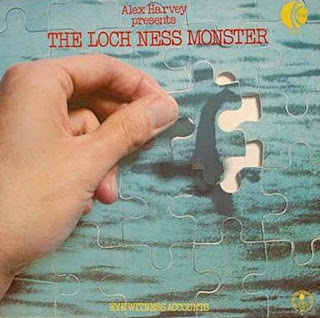 Front cover of 'Alex Harvey Presents: The Loch Ness Monster', a long-deleted LP (© K-Tel)
Front cover of 'Alex Harvey Presents: The Loch Ness Monster', a long-deleted LP (© K-Tel)The Sensational Alex Harvey Band (1978). 'Water Beastie'.The SAHB with Harvey fronting also recorded a Nessie song, 'Water Beastie', which appeared as track #8 on their 1978 album 'Road Drill', and was co-written by Harvey, Chris Glen, and Hugh McKenna, all from SAHB. Listen to it here .
The Police (1983). 'Synchronicity II'.Appearing as track #6 on this seminal English rock band's album 'Synchronicity' and also released as a single in 1983, this song tells of two unrelated events that are happening simultaneously – a demeaned, harried husband and father's life descending into increasing depression and despair, while, far away, a monstrous entity emerges from a dark Scottish loch and moves ominously, inexorably, towards a lochside cottage. It was written by the band's lead singer/bassist, Sting, and can be viewed and listened to here .
One of the most popular animated children's TV series in Britain during the early 1980s was The Family Ness, which was created by English cartoonist Peter Maddocks of Maddocks Cartoon Productions, consisted of 25 five-minute episodes, and was originally screened on BBC 1, beginning in 1983. As its name suggests, its stars were a family of Nessies, plus two children, Elspeth and Angus MacTout, who could call the Nessies from their loch using secret thistle whistles. Each of the Nessies (of which there were many) was punningly named after their defining trait, and included among their number Clever Ness, Grumpy Ness, Lovely Ness, Hungry Ness, Silly Ness, and the daunting Ferocious Ness. The opening titles of each episode were accompanied by a catchy song, and a second equally catchy song accompanied the end credits of each one. Both were written by English songwriter Roger Greenaway and music composer Gavin Greenaway (Roger's son), and in 1985 they were released by the BBC in single format:
The Family Ness (1983). 'The Family Ness'. This song was played over the opening titles to each episode of The Family Ness. No vocalist screen credit was aired, but it has been suggested that Gavin Greenaway himself may have been the singer, as he was aged approximately 20 at that time, and the singer sounds like someone of around that same age (ditto for the end credits song too – see next song entry).
The Family Ness (1983). 'You'll Never Find a Nessie in the Zoo'.An extended, full-length version of this song, hitherto played only in brief, incomplete form over each episode's end credits, appeared in the very last episode of this TV series, and became the video for the song when released as a single. My dear little Mom, Mary Shuker, absolutely adored both the song and the video, and whenever I played it (having taped it on videocassette) she would always stop whatever she was doing and watch it, laughing with delight. Happy days, happy memories. Watch and listen to it here .
 'You'll Never Find a Nessie in the Zoo', single (© BBC Records/Wikipedia)
'You'll Never Find a Nessie in the Zoo', single (© BBC Records/Wikipedia)Stuart Anderson (1992). 'Nessie (The Loch Ness Monster)'.Mom was also a big fan of this act. In 1989, at the tender age of six, pint-sized Scottish singer Stuart Anderson's highly-polished performance of 'Bonnie Wee Jeannie McColl' in the annual 'Young Entertainer of the Year' competition staged on BBC1's Saturday morning teenage television show Going Live so entranced the voting public that he ultimately won it by the biggest margin of votes ever recorded in this competition. On the back of his success, Stuart went on to release several albums, one of which, 'Stuart Anderson Acts Naturally', released in 1992, contained the cheery singalong song 'Nessie (The Loch Ness Monster)'. Today, aged 32 and a well-respected guitar teacher, Stuart's very youthful showbiz days are long behind him, but he remains forever young - and forever singing about Nessie (not to mention Bonnie Wee Jeannie McColl!) – here on YouTube.
Phyllis Logan (1992). 'Shy Girl'.This song comes from a British animated feature film entitled Freddie as F.R.O.7., which was released in 1992 (and retitled as Freddie the Frog in the USA). A James Bond parody, it tells the somewhat complicated story of Frederic, a medieval prince and heir to his country's throne, who is turned into a frog by his evil aunt Messina (who has already secretly killed his parents in her bid to become ruler), after which he travels through a time zone into the 20thCentury, becomes a member of the French Secret Service (F.R.O.7.) as Freddie the Frog, and is then sent by them to Britain in order to foil a plot by arch-villain El Supremo and Messina to enslave the world's population. Somewhere in amongst all of this mayhem, Freddie encounters Nessie (voiced by Phyllis Logan) and her many other long-neck relatives in Loch Ness, and she informs him in song (and dance) of what a shy girl she really is. An excerpt from the film that includes this song, and which in my opinion is both the most entertaining and the most beautifully animated section of the entire film, can be viewed here .
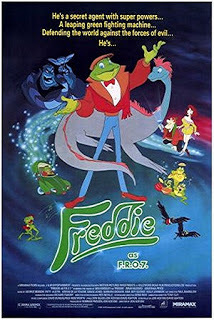 Theatrical film poster for Freddie as F.R.O.7. (© Rank Films – inclusion here via Wikipedia, on strictly Fair Use non-commercial basis only)
Theatrical film poster for Freddie as F.R.O.7. (© Rank Films – inclusion here via Wikipedia, on strictly Fair Use non-commercial basis only)Pater Moeskroen (1992). 'Nessie'.This is a Dutch folk band but their music is also infused with Celtic, klezmer, and punk elements. Their LNM song, from an early 1990s album, is apparently all about Nessie's, ahem, intimate liaisons with other loch monsters – but I don't speak Dutch, so I wouldn't know... Listen to it here .
Some Velvet Sidewalk (1992). 'Loch Ness'.American experimental lo-fi rock band Some Velvet Sidewalk released two different versions of their Nessie-themed song 'Loch Ness' (listen to it here ). One version appeared as track #2 on their own 1992 album, 'Avalanche'; the other had appeared a year earlier, again as track #2, but this time on 'Kill Rock Stars', which was a compilation album featuring a number of different acts.
Those Darn Accordions (1996). 'Deathbed Confession'. This song from San Francisco accordion band Those Darn Accordions' 1996 album 'No Strings Attached' takes its inspiration from the 'deathbed confession' claim of Christian Spurling in 1993 regarding his supposed hoaxing of the famous Surgeon's Photograph, by having allegedly made a head-and-neck model of Nessie, attached it to a toy submarine, and set it afloat on Loch Ness one day in April 1934, where it was then deliberately photographed by gynaecologist and co-conspirator Robert Kenneth Wilson, yielding the iconic photo, which they then passed off to the media as a genuine Nessie image.
The Real McKenzies (2001). 'Nessie'. This song is the opening track to Canadian Celtic punk band The Real McKenzies' 2001 album 'Loch'd and Loaded', and is basically a protest song regarding the search for and potential future capture of Nessie.
Judas Priest (2005). 'Lochness'.This lengthy track (13.28 minutes long) is the tenth and final one on world-famous British heavy metal band Judas Priest's fifteenth studio album, 'Angel of Retribution', and was co-written by their legendary leather-clad frontman, Rob Halford, returning to the band after an absence of 15 years. Listen to it here .
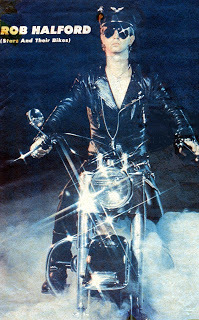 Judas Priest lead singer Rob Halford – not only a fellow biker and a fellow West Midlander (we were born just a few miles from one another) but also, it would seem, a fellow Nessie enthusiast! (© Rob Halford/Kerrang!)
Judas Priest lead singer Rob Halford – not only a fellow biker and a fellow West Midlander (we were born just a few miles from one another) but also, it would seem, a fellow Nessie enthusiast! (© Rob Halford/Kerrang!)Honorary mentions are also due to the following three songs, which are not themselves about Nessie but feature Nessie-themed official videos in the first two instances and in the third instance is the title track of an entire Nessie-themed movie:
Reggie and the Full Effect (2005). 'Get Well Soon'.The video to this song, track #2 from Kansas City rock band Reggie and the Full Effect's 2005 album 'Songs Not To Get Married To', features the collapse and total disintegration of a green, suspiciously arm-puppet-like Loch Ness monster's entire life, beginning with a savage divorce settlement in which he loses his loch and is forced to roam the streets homeless as his life falls apart, reduced to living in cardboard boxes. Unrelentingly dark and grim, there is no happy ending for this video's LNM. Watch it here to see for yourself.
The Automatic (2006). 'Monster'.In pleasant contrast, the video to this 2006 song, track #5 on Welsh rock band The Automatic's debut album 'Not Accepted Anywhere', is pure slapstick comedy, featuring a Nessie whose vertical neck rising above the loch's surface is of veritable skyscraper proportions yet somehow still manages to go unnoticed by the band, starring here as hapless monster seekers. So too does a dancing bigfoot that definitely gets down and gets with it as their song plays, before things finally hot up in every sense for our heroes when they have an exceedingly close encounter with a UFO. View it here .
Adam Faith (1961). 'What a Whopper'.Also well worth including here is this title track to a British b/w comedy film from 1961 entitled What a Whopper, featuring an attempt by a young struggling would-be novelist to raise money by writing a book about the Loch Ness Monster and then, to generate plenty of publicity for it and thus ensure its success, staging a hoaxed Nessie sighting - only for the real Nessie herself to make a surprise, and very tongue-in-cheek, appearance at the very end of the film. It starred British rock'n'roll singer (and later actor) Adam Faith, who also sang the toe-tapping theme song (written by Johnny Worth) that opens the film. View and listen to it here .
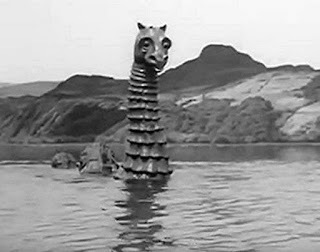 Nessie making her long-awaited appearance in the closing scene of What a Whopper (© Viscount Films)
Nessie making her long-awaited appearance in the closing scene of What a Whopper (© Viscount Films)In addition to those songs documented above, in which Nessie features extensively in the lyrics, there are a fair few others in which she is mentioned briefly or in passing. No less than 57 of these, recorded by the likes of Eminem, Roger Taylor, Pras, De La Soul, and Crash Test Dummies among others, can be accessed here .
Finally: Although by far the most extensively represented example, Nessie is not the only water monster to have inspired various songs and other musical compositions. Here are three notable non-LNM examples:
THE LAKE OKANAGAN MONSTER: Paul Whiteman Orchestra (1924). 'The Ogo-Pogo – The Funny Fox-Trot'.As every self-respecting cryptozoological enthusiast will readily confirm, this is the English music-hall song from 1924, composed by Mark Strong, that subsequently gave its name to the now-famous water monster of Canada's Lake Okanagan (until then, it had been known only as the naitaka - a traditional Native American name given to it by the local Okanakane nation). Despite the song featuring a banjo-playing terrestrial monster from Hindustan (additionally sporting a pair of antennae and wearing boots in the delightful illustration by Fred Low adorning its sheet music's front cover) - far removed indeed from Canada's unequivocally non-musical aquatic cryptid of serpentiform shape – the name Ogopogo stuck, and the Lake Okanagan monster has been affectionately referred to by it ever since.
 Front cover of my original copy of the sheet music for the Savoy HavanaBand's version of 'The Ogo-Pogo – The Funny Fox-Trot' (© Dr Karl Shuker)
Front cover of my original copy of the sheet music for the Savoy HavanaBand's version of 'The Ogo-Pogo – The Funny Fox-Trot' (© Dr Karl Shuker)For further details concerning this song (which can be listened to here ), and how I was fortunate enough to encounter and purchase a copy of the sheet music for the Savoy Havana Band's original version of it from 1924, thereby enabling me to include its front cover illustration for the very first time in any cryptozoological publication, please click here . Several different acts released this song in 78 rpm record format during the 1920s, including the Paul Whiteman Orchestra in 1925, featuring Billy Murray as vocalist singing reworded American lyrics rather than the original English ones written by Cumberland Clark (click link below), the Savoy Havana Band (see illustration above), Meyer Davis' Swanee Syncopaters, and George Berry (aka Harry Fay).
THE PATAGONIAN PLESIOSAUR: Arturo Terri (1922). 'El Plesiosaurio Tango'.Seemingly as elusive as the lake-dwelling Patagonian long-neck that it celebrates, this exotic-sounding crypto-composition has evaded every attempt not only by me but also by several friends and correspondents on Facebook to track down an online recording of it – but this is only fitting, I suppose, bearing in mind that its subject also succeeded in remaining concealed from those searching for it.
 Dr Clemente Onelli - seeker of the Patagonian plesiosaur (public domain)
Dr Clemente Onelli - seeker of the Patagonian plesiosaur (public domain)With lyrics by Amilcar Morbidelli), it was composed in 1922 by Rafael D'Agostino to commemorate Argentinian biologist Dr Clemente Onelli's expedition during April of that same year to a mountain lake near Esquel in Argentina, seeking the so-called Patagonian plesiosaur that had allegedly been sighted there by an itinerant Texan adventurer called Martin Sheffield who had lived off the land in Patagonia for many years. Sponsored by Buenos Aires Zoo, of which Onelli was the director, the expedition did reach this lake, but no sightings of cryptids were made (further details can be found in my book In Search of Prehistoric Survivors ). D'Agostino dedicated his plesiosaur tango to Onelli (who died in 1924), a caricature of whom is humorously portrayed riding the plesiosaur on the front cover of the Arturo Terri version of this composition's sheet music.
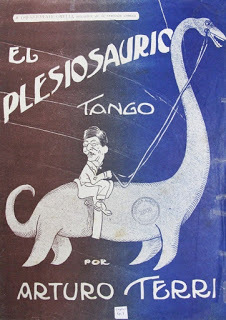 Front cover of the sheet music for Arturo Terri's version of 'El Plesiosaurio Tango' (public domain)
Front cover of the sheet music for Arturo Terri's version of 'El Plesiosaurio Tango' (public domain)If anyone reading this ShukerNature blog article knows of an online recording of 'El Plesiosaurio', I'd greatly welcome details. Meanwhile, here is a link to its Spanish lyrics.
Incidentally, this was not the only 1920s musical composition inspired by Onelli's Patagonian pursuit of plesiosaurs. Here is the delightful front cover illustration from Fernando Randle's piano sheet music for his own tango, 'El Plesiosauro' (note the slight difference in its title's spelling from that of D'Agostino's tango), featuring a very dapper pipe-smoking plesiosaur with top hat, spats, and cane! Sadly, however, Randle's plesiosaur tango was not as popular as D'Agostino's. Once again, I haven't been able to locate an online recording of it, so I'd greatly appreciate any assistance in doing so.
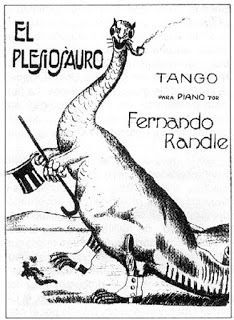 Front cover of the piano sheet music for Fernando Randle's 'El Plesiosauro' tango (public domain)
Front cover of the piano sheet music for Fernando Randle's 'El Plesiosauro' tango (public domain)Julio Fava Pollero's 'Antediluvian Tango' was a third tango inspired by Onelli's plesiosaur hunt, but although he performed with his own orchestra he never released this composition in record form, only as sheet music, published in 1927. This was because by then the swell of public interest in the Patagonian plesiosaur expedition had subsided. Its sheet music's front cover depicted a humorous caricature of Onelli attempting to tie the plesiosaur down.
My sincere thanks to several Facebook friends, especially Karl J. Claridge, Claudio Diaz, Adam Naworal, Jeff Rausch, and Valerie Wyllie, for supplying me with information and images relating to this trio of Patagonian plesiosaur tangos.
THE GREAT SEA SERPENT: Maurice Strakosch (1850). 'Sea Serpent Polka'.Inspired by a bout of sea serpent sightings off the towns of Gloucester and Nahant in Massachusetts, New England, USA, during 1817-1819, this very jaunty polka was written in 1850 by Maurice Strakosch, an American musician of Czech origin, and featured an immense snake-like sea serpent coiled upon the front cover of its sheet music. An undated recording of concertina player Michel Van Der Meiren performing this lively tune can be listened to here on YouTube.
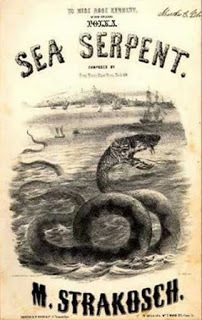 Front cover of the sheet music for 'Sea Serpent Polka' (public domain)
Front cover of the sheet music for 'Sea Serpent Polka' (public domain)Many thanks indeed to Facebook friend Jeff Meuse for bringing this charming instrumental composition to my attention.
I do hope that you've enjoyed this very special Nessie concert here on ShukerNature. If so, then that is definitely music to my ears!
This ShukerNature blog article is excerpted from my book Here's Nessie! A Monstrous Compendium From Loch Ness – coming soon!
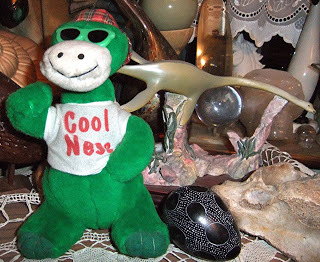 Nessie - the coolest crypto-rock star of them all! (© Dr Karl Shuker)
Nessie - the coolest crypto-rock star of them all! (© Dr Karl Shuker)
Published on September 23, 2015 15:25
September 18, 2015
FLUORESCENT FLORA - UNEXPLAINED REPORTS OF GLOWING, LIGHT-EMITTING FLOWERS
 What a light-emitting orange-petalled flower might look like in the dark (public domain)
What a light-emitting orange-petalled flower might look like in the dark (public domain)A still-unexplained yet little-known wildlife-related phenomenon is the extraordinary occurrence, discussed by several naturalists during the 19th Century, of sparks and flame-like flashes of light unexpectedly emitted by certain plants. Those most commonly associated with this bizarre enigma are species such as marigolds and geraniums, which possess red, orange, or yellow flowers.
 A beautiful yellow version of the common marigold Calendula officinalis (public domain)
A beautiful yellow version of the common marigold Calendula officinalis (public domain)In 1843, the following account of an observation with common marigolds, penned by Richard Dowden, appeared in Part 2 of that year's Report of the British Association:
This circumstance was noticed on the 4th of August, 1842, at eight p.m., after a week of very dry warm weather; four persons observed the phaenomenon [sic]; by shading off the declining daylight, a gold-coloured lambent light appeared to play from petal to petal of the flower, so as to make a more or less interrupted corona round its disk. It seemed as if this emanation grew less vivid as the light declined; it was not examined in darkness, which omission will be supplied on a future occasion. It may be here added, in the view to facilitate any other observer who may give attention to this phaenomenon, that the double marigold is the best flower to experiment on, as the single flower "goeth to sleep with the sun," and has not the disk exposed for investigation.
 Can marigolds really emanate light? (public domain)
Can marigolds really emanate light? (public domain)In 1882, Scientific Americanpublished a short note on this same subject by Louis Crie:
In living vegetables emissions of light have been observed in a dozen phaenogamous plants and in some fifteen cryptogamous ones. The phosphorescence of the flowers of Pyrethrum [Chrysanthemum] inodorum, Polyanthes [sic -Polianthes] (tuberose), and the Pandani has been known for a long time. Haggren and Crome were the first to discover such luminous emanations from the Indian cross and marigold, and a few years ago I myself was permitted to observe, during a summer storm, a phosphorescent light emitted from the flowers of a nasturtium (Tropoeolum [sic - Tropaeolum] majus) cultivated in a garden at Sarthe.
Several reports concerning light-emitting flowers appeared during the 1880s in the English periodical Knowledge. These revealed that one early eyewitness had been none other than the daughter of Carolus Linnaeus, the father of modern botanical and zoological classification, who witnessed this phenomenon while gazing at some garden flowers one summer twilight in 1762.
 To misquote Gary Numan, are flowers electric?? (© Robby Ryke/
Creative Commons Licence
)
To misquote Gary Numan, are flowers electric?? (© Robby Ryke/
Creative Commons Licence
)A later eyewitness, a Mr S. Ingham, reported his sighting in Knowledge in 1883:
A short time ago, I was picking out some annuals on a flower-bed, on which some geraniums were already planted, when I was surprised to see flashes of light coming from a truss of geranium flowers. At first I thought it was imagination, but my wife and a friend who were present also saw them. Time was about 9 p.m., and the atmosphere clear. There were other geraniums of a different colour on the same bed, but there was no effect on them. The particular geranium was a Tom Thumb. Is this at all common? I have never seen or read of it before.
 A field of light-emitting sunflowers would be a spectacular if inexplicable sight, and yet such flowers have indeed been claimed to possess this incredible ability (public domain)
A field of light-emitting sunflowers would be a spectacular if inexplicable sight, and yet such flowers have indeed been claimed to possess this incredible ability (public domain)In fact, eleven years earlier a tome published by Simpkin, Marshall, & Co, entitled Lessons in Physical Science, had included the following comments regarding this curious matter:
To the same source - electricity - we probably owe the light which, at certain seasons, and at certain times of the day, issues from a number of yellow or orange-coloured flowers, such as the marigold, the sunflower, and the orange-lily...similar phenomena have been witnessed by several naturalists. Flashes, more or less brilliant, have been seen to dart in rapid succession from the same flower. At other times the tiny flame-jets have followed one another at intervals of several minutes.
 The sunflower Helianthus annuus is so bright that it almost appears to radiate light even under normal circumstances (public domain)
The sunflower Helianthus annuus is so bright that it almost appears to radiate light even under normal circumstances (public domain)Flowers releasing visible discharges of electricity is undeniably a somewhat dramatic concept. A less radical alternative, perhaps, is that this curious optical effect may be caused by the reflection of sunlight by petals of certain colours acting as miniature mirrors (thus explaining why the effect lessens as daylight declines).
Whatever the answer, however, it is certainly true today that light-emitting flowers have become one of the forgotten phenomena of botany, ignored - if indeed even known about - by contemporary researchers. Yet they were once known, and witnessed, by naturalists.
 Cultivated version of the orange lily Lilium bulbiferum, another species alleged to emit flashes of light (public domain)
Cultivated version of the orange lily Lilium bulbiferum, another species alleged to emit flashes of light (public domain)Surely, therefore, it is time for a new generation to rediscover these excluded enigmas, and extract their long-hidden secrets. After all, as succinctly pointed out by the late, much-missed fortean writer Mark Chorvinsky regarding this mystifying subject: "There are a lot of marigolds and geraniums out there".
So if anyone reading this ShukerNature blog article has ever witnessed light-emitting flowers, I'd be very interested to receive details if you'd like to post them here.
 An eyecatching array of cultivated bright-orange marigolds (© H. Zell/Wikipedia
Creative Commons Licence
)
An eyecatching array of cultivated bright-orange marigolds (© H. Zell/Wikipedia
Creative Commons Licence
)This ShukerNature blog article was excerpted from my book Mysteries of Planet Earth .

Published on September 18, 2015 20:07
September 13, 2015
WHEN TRUNKO MET NESSIE?? - PARADOX OF THE PICTISH BEAST
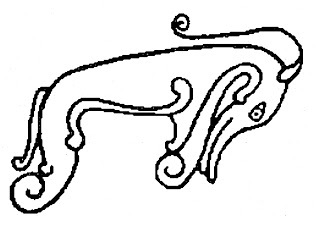 Line diagram of the Pictish beast (public domain)
Line diagram of the Pictish beast (public domain)Named after their very distinctive body tattoos, the Picts ('painted people') inhabited northeastern Scotlandas a separate tribe from c.300 AD to 850 AD, after which they were united with the Celtic Scots under the reign of King Kenneth I. The Picts can boast as their principal claim to archaeological fame their ornately-carved symbol stones. These are elaborately decorated with various creatures, objects, and other depictions, especially the earlier, pre-Christian stones - which are designated as Class I (dating from the 6th Century, generally unshaped, and bearing line-incised symbols on at least one flat face) or Class II (of rather later date, and bearing much more intricate, flamboyant designs). Class III stones, conversely, date from when Christianity reached the Picts, so on these stones the earlier Pictish symbols have been mostly replaced by Christian ones.
Due to their realistic designs, the many different animal types carved on Class I and II Pictish symbol stones are readily identifiable – with one notable exception, that is. Appearing on about 29 Class I stones and 22 Class II stones, this bizarre-looking exception is known as the Pictish beast.
 Close-up of Pictish beast depicted on Meigle 4 Stone at Meigle Sculptures Stone Museum (© Simon Burchill/Wikipedia)
Close-up of Pictish beast depicted on Meigle 4 Stone at Meigle Sculptures Stone Museum (© Simon Burchill/Wikipedia)Several very famous Pictish symbol stones bear depictions of it. These include: the Dunfallandy Stone (Class II) in Tayside; one of the Rhynie Pict stones in Aberdeenshire; and the 6-ft-tall Rodney's Stone (Class II), which is a cross-slab of grey sandstone originally present in the graveyard of the old church of Dyke and Moy but subsequently transferred to the Grampian village of Dyke to commemorate Admiral Rodney's victory and standing today on the left side of the avenue leading to Brodie Castle.
Other symbol stones depicting the Pictish Beast are a cross-slab on the Brough of Birsay at the northwestern corner of Mainland, Orkney; the 9th-Century, 10-ft-tall Maiden Stone near Pitcaple in Aberdeenshire; and a carved stone in Grampian's Port Elphinstone Henge near Inverurie (the henge itself is much older than the carvings). Perhaps the least stylised, most 'natural' portrayal of this mystifying creature can be found upon a spectacular Class II stone at Tayside's Meigle Sculptures Stone Museum, which is adorned with carvings of horse riders and a tail-biting serpent as well as the Pictish beast, plus the customary Pictish V-rod and crescent symbols.
 Pictish beast depicted on Meigle 5 Stone at Meigle Sculptures Stone Museum (© Simon Burchill/Wikipedia)
Pictish beast depicted on Meigle 5 Stone at Meigle Sculptures Stone Museum (© Simon Burchill/Wikipedia)Depictions of it on such symbol stones as these portray this bizarre creature with a dolphin-like head, a long beak, four limbs that often curl backwards underneath its body (although sometimes, as on the Meigle Museum stone, only the paws curl backwards), an elongate tail with a noticeable curl at its tip, and, most distinctive of all, what may be a long slender horn or even a trunk-like projection sprouting from the top of its head and curving over its back. Indeed, this last-mentioned feature has earned the Pictish beast the alternative name of 'swimming elephant' (which all too readily conjures up some decidedly surreal images of a Celtic version of Trunko! - click here to read all about this latter onetime monster of misidentification).
Needless to say, no known species of animal resembles the Pictish beast as so portrayed, which in turn has incited appreciable speculation and controversy among historians and archaeologists as to what it may be. One popular, conservative identity for it is a dolphin (or even a beaked whale, i.e. a ziphiid), based upon its beaked, superficially dolphin-like head - as a result of which I wonder if its anomalous 'trunk' may in reality be a representation of a spout of water spurting upwards when the dolphin exhales through its blowhole (conjoined, modified nostrils), which is indeed situated on the top of this marine mammal's head. Conversely, the unequivocally leg-like limbs and non-fluked tail of the Pictish beast are radically different from the flippers and fluked tail of dolphins and other cetaceans.
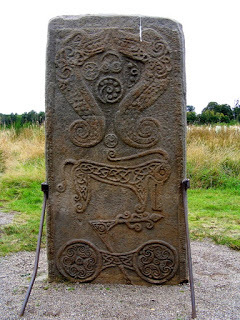 Pictish beast depicted on Rodney's Stone at Brodie Castle (© Ann Harrison/Wikipedia)
Pictish beast depicted on Rodney's Stone at Brodie Castle (© Ann Harrison/Wikipedia)Other postulated suggestions include a seahorse (especially when depicted vertically), a deer, a seal, and a dragon. A bona fide elephant or even an unknown species of secondarily aquatic elephant has also been considered (albeit not seriously, for obvious reasons!). It may simply be that the Pictish beast is an entirely fictitious, imaginary creature, possibly even a composite of several different creatures, but its numerous portrayals (accounting for approximately 40 per cent of all Pictish depictions of animals) imply that it had considerable symbolic significance for the Picts.
Indeed, it may even be the earliest known artistic representation of the legendary kelpie or Scottish water-horse (click here for a ShukerNature article on this malevolent entity). One of the three Aberlemno symbol stones in Tayside depicts a pair of interlaced horse-headed, elongate aquatic monsters, and some scholars have suggested that these may constitute a more sophisticated version of the Pictish beast.
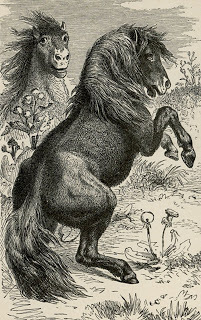 A rearing kelpie – is this the identity of the Pictish beast? (public domain)
A rearing kelpie – is this the identity of the Pictish beast? (public domain)Moreover, in their book Ancient Mysteries of Britain (1986), Janet and Colin Bord proposed that the Pictish beast might be a direct representation of the elusive water monsters allegedly inhabiting various of Scotland's lochs, its 'trunk' explaining the familiar 'head and neck' or 'periscope' images often reported and even photographed by Nessie eyewitnesses. Backing up their fascinating hypothesis, the Bords make the following very telling observation:
"Since a whole range of animals and birds is accurately depicted on the symbol stones - wolf, bull, cow, stag, horse, eagle, goose - perhaps these were the creatures most familiar to the Picts in their everyday world, and 'monsters' were also familiar to them, being more often seen in the lakes than they are today, and accepted as part of the natural world just like eagles and stags."
This in turn leads to the most intriguing and original (if zoologically offbeat) identity ever put forward for the Pictish beast. A familiar figure in the British Fortean community for many years, Tony 'Doc' Shiels describes himself as a monster-hunter, stage magician, surrealist artist, and shaman of the western world (among other things), and he has suggested that the Pictish beast may indeed be a depiction of the unidentified Scottish water monsters. Moreover, as he first documented in a Fortean Times article (autumn 1984) and further propounded six years later in his book Monstrum! A Wizard's Tale (1990), and as I have also referred to briefly earlier in this present book (see Chapter 7), he has speculated that these latter mystery beasts' zoological identity could in turn be a highly novel, specialised form of squid.
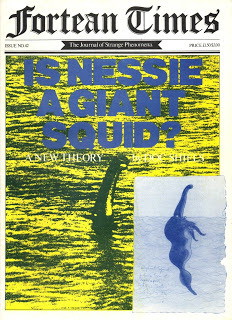 Front cover of Fortean Times #42 (autumn 1984), depicting 'Doc' Shiels's conjectured elephant squid at bottom-right (© Fortean Times/Tony 'Doc' Shiels)
Front cover of Fortean Times #42 (autumn 1984), depicting 'Doc' Shiels's conjectured elephant squid at bottom-right (© Fortean Times/Tony 'Doc' Shiels)But how could such a creature be equated with Nessie and company, and how firm are its basic anatomical and physiological foundations? Here is what I wrote about Shiels's proposed 'Pictish squid' in my book Mysteries of Planet Earth (1999):
"As conceived by Shiels, the most striking feature of his hypothetical species is a long, flexible, prey-capturing proboscis-like structure (the trunk of the Pictish beast), on account of which he has dubbed this creature the elephant squid. If held out of the water, its proboscis could resemble a long neck, which Shiels believes may explain the familiar 'long-neck' images of Nessie and her kin. He also provides his elephant squid with inflatable dorsal airsacs as part of its buoyancy mechanism (which could yield the varying shape and number of humps reported for Nessie), six short tentacles, and a pair of longer curling arms (the Pictish beast's curling front legs), as well as a muscular tail bearing two horizontal lobes.
"In his accounts, Shiels proposes that this remarkable mollusc may even be able to emerge briefly onto land, which might therefore explain why certain Nessie eyewitnesses (such as the Spicers, who claimed to have spied this mystery beast on land in 1933) have likened it to an enormous, hideous snail. Quite apart from the profound morphological modifications necessary for a beast corresponding to Shiels's elephant squid to have evolved from known cephalopod (squid and octopus) stock, however, a fundamental obstacle to this hypothetical creature's plausibility is that all known species of modern-day cephalopod are exclusively marine. There is not a single species of freshwater squid or octopus on record, and for one to evolve would require drastic tissue modifications relating to osmoregulatory ability."
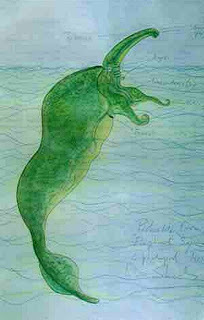 Doc Shiels's sketch of his hypothetical elephant squid (© Tony 'Doc' Shiels)
Doc Shiels's sketch of his hypothetical elephant squid (© Tony 'Doc' Shiels)Shiels's Fortean Timesaccount attracted considerable interest within and beyond the Fortean and cryptozoological fraternity, and summaries of his speculation subsequently appeared in a wide range of publications by other writers. Regrettably, however, many of these second-hand accounts mistakenly claimed that Shiels had formally dubbed his hypothetical elephant squid Dinoteuthis proboscideus (translating, incidentally, as 'trunked terrible squid'). In reality, conversely, as Shiels went on to explain in Monstrum!, Irish zoologist A.G. More had already given that particular name to a massive squid specimen beached at Dingle in County Kerry, Ireland, in October 1673 during a major storm. Instead, Shiels suggested that an apt name for his own, totally conjectural cephalopod would be Elephanteuthis nnidnidi - a name that needs no explanation for anyone knowing of Shiels's experiments with psychic automatism.
More recently, mystery beast researcher Scott Mardis from the USAhas suggested that the Pictish beast images may actually depict an evolved, surviving species of short-necked plesiosaur (and therefore quite probably a pliosaur, which also had long jaws like those of the Pictish beast). Plesiosaurs have of course been officially extinct for at least 64 million years, but an evolved, surviving representative of the long-necked, short-jawed version (elasmosaur) of these aquatic prehistoric reptiles nevertheless has long been a popular cryptozoological identity for Nessie-type water monsters.
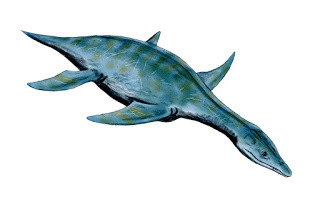 Leptocleidus capensis
, a short-necked, long-jawed plesiosaur from the early Cretaceous (© Nobu Tamura/Wikipedia)
Leptocleidus capensis
, a short-necked, long-jawed plesiosaur from the early Cretaceous (© Nobu Tamura/Wikipedia)In short, the Pictish beast remains the subject of several interesting interpretations, but no satisfactory solutions - unless of course the answer lurks not among its petroglyphic portrayals but instead within the secretive depths of the lochs forming a major, familiar part of the landscape once inhabited by the painted people of Scotland's distant past?
This ShukerNature blog article is excerpted from my forthcoming book Here's Nessie! A Monstrous Compendium From Loch Ness .
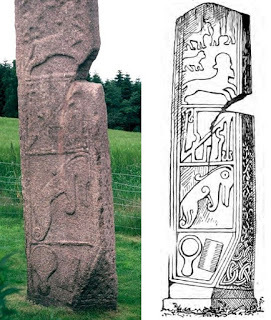 Pictish beast depicted on the east side of the Maiden Stone in a photograph (© Ronnie Leask/Wikipedia) and a line drawing (public domain)
Pictish beast depicted on the east side of the Maiden Stone in a photograph (© Ronnie Leask/Wikipedia) and a line drawing (public domain)
Published on September 13, 2015 12:53
September 11, 2015
A GIANT DOG-FANGED MYSTERY FROG FROM THE CONGO
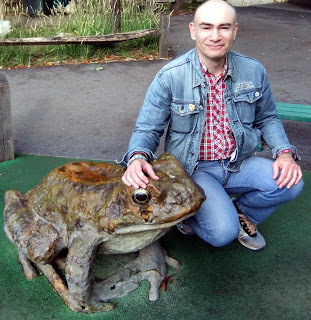 Alongside a statue of a hypothetical giant frog (© Dr Karl Shuker)
Alongside a statue of a hypothetical giant frog (© Dr Karl Shuker)The 20thCentury opened with one of the most dramatic amphibian discoveries of all time – the aptly-named goliath frog Conraua goliath. Up to 14.5 in long from snout to vent, plus a pair of enormous hind legs, and weighing up to 8 lb, it is the world's biggest known species of living frog (or toad, for that matter), as large in fact as certain antelopes with which it shares its Middle African domain (for further details regarding this remarkable amphibian's scientific unveiling, see my book The Encyclopaedia of New and Rediscovered Animals ). However, another very sizeable African frog remains unidentified and unexamined by science almost 70 years after it was first documented.
On 31 December 1945, an article penned by Harvard University herpetologist Arthur Loveridge was published in the zoological journal Copeia, concerning an attack some months earlier upon an askari (native policeman) at Tapili, Niangara, in what was then the Belgian Congo (later renamed Zaire, and now called the Democratic Republic of Congo). Loveridge's source of information concerning this incident was a Mr C. Caseleyr, then Administrator of the Niangara Territory. The askari had come to Caseleyr to inform him that while walking by a pool earlier that evening, he had been bitten on one of his legs by what proved to be a very large frog – he'd lunged out at his attacker with a large club that he was carrying and had killed it outright. And as conclusive proof of his statement, the askari had brought with him the frog's body to show it to Caseleyr.
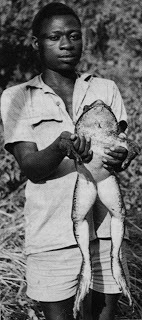 A goliath frog Conraua goliath (© Dr Jordi Sabater Pi)
A goliath frog Conraua goliath (© Dr Jordi Sabater Pi)What was even more surprising than the fact that he'd been attacked by such a creature, however, was the wound that it had produced. For when Caseleyr examined the askari's leg, he could see two puncture marks resembling the wounds that a dog's teeth would leave – and that was not all. When he then examined the dead frog, Caseleyr was very startled to discover that its upper jaw and lower jaw each possessed a pair of sharp teeth that actually did resemble a dog's canine teeth, and its tongue was forked like a snake's. The frog was grey-green in colour dorsally, with a large orange patch on its chest and stomach, and in general shape and size was very large, broad, and fat (though no specific measurements for it were provided by Loveridge).
Loveridge referred to this animal throughout his article as a frog, but Caseleyr personally felt that it seemed more like a toad, although he freely confessed that he had no informed knowledge on such matters. However, Loveridge stated that the creature's notched tongue eliminated a toad as its identity. Yet he also recognised that its description (and most especially the presence of two teeth-like projections in its upper jaw, not just in its lower jaw) readily differentiated this sizeable mystery frog from all known species in that region. Consequently, albeit with great hesitation, Loveridge concluded his article by speculating that "it may be that some large species remains to be discovered in the Niangara region". Yet if so, it has somehow managed to elude scientific detection for several decades since then (and continues to do so today). Impossible? Perhaps not...
This ShukerNature blog article is excerpted from a comprehensive chapter devoted exclusively to cryptic frogs and toads contained in my latest, newly-published book, A Manifestation of Monsters – so be sure to check it out!
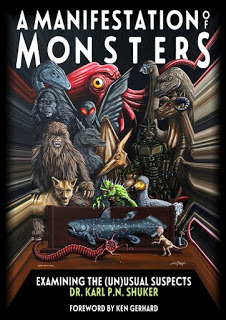
Published on September 11, 2015 13:40
September 5, 2015
THE PELUDA – SHAGGY SURVIVOR OF NOAH'S GREAT FLOOD
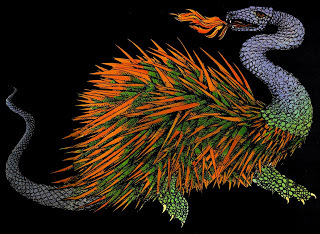 The peluda or shaggy beast (© Helena Zakrzewska-Rucinska/Dr Karl Shuker/Marshall Editions; this splendid illustration was specially commissioned for my book Dragons: A Natural History)
The peluda or shaggy beast (© Helena Zakrzewska-Rucinska/Dr Karl Shuker/Marshall Editions; this splendid illustration was specially commissioned for my book Dragons: A Natural History)When I was researching the first of my two books on dragons, Dragons: A Natural History , published in 1995, a certain trio of French dragons attracted my particular interest. For each of these monsters not only featured in its own fascinating legend, but also was exceptionally unusual in morphology and behaviour. Yet, surprisingly, none of them had previously attracted much attention in dragon books. Consequently, I swiftly remedied that sad situation by devoting a detailed section to each one, in which I recounted its legend and illustrated it with reconstructions of their supposed appearance.
These three remarkable reptilians were the tarasque, the peluda, and the gargouille. I have already excerpted my above-cited book's tarasque account on ShukerNature (click here ) and I will be doing the same at some stage in the future with the gargouille. Today, however, it is the turn of the peluda to take centre-stage, so here is my book's account of this very memorable monster:
There on the bank of the river Huisne, at La Fert‚-Bernard in medieval France, something was definitely moving. Suddenly, what appeared at first to be the head and sinuous body of a huge viper-like snake emerged from a spherical mass of bright green vegetation, and reared upwards above it. Moments later, however, the vegetation itself began to move, quivering as if it were a living creature - which was only to be expected, for that was precisely what it was. What had seemed to be nothing more than a cluster of riverside foliage was in reality the round body of a huge animal with shaggy green fur - and what had appeared to be a giant serpent was now exposed as this extraordinary animal's head and neck!
It was the peluda - a terrifying amphibious neo-dragon also known as the shaggy beast ('la velue'), which had been spawned in early biblical days and was refused entry onto Noah's Ark, yet had nonetheless survived the Great Flood, and was now terrorising the environs of La Fert‚-Bernard. Its dense green pelage partially hid four horny, turtle-like feet, and bristled with countless numbers of spine-like quills - which contained potent stinging venom, and could be jettisoned like poisonous javelins into anything unwary enough to approach too closely. This monstrous beast could also kill a person with a mighty thwack of its immensely powerful tail - and when it was sufficiently angered, a single blast of flame spewed forth from its coiled throat could incinerate fields for miles around.
For a time, the peluda had contented itself with raiding farms and stables each night in search of horses and other livestock as prey - robbing the farmers of their livelihood, but rarely of their lives, unless they were foolish enough to challenge its depredations.
Occasionally, massed attacks on the beast by brave companies drawn from the local populace had succeeded in driving it into the Huisne - but the peluda was of such colossal size that whenever it submerged itself underwater, the river immediately overflowed its banks, and much of the district bordering on either side was completely flooded, thereby causing as much devastation to the farmers as the monster's own onslaughts.
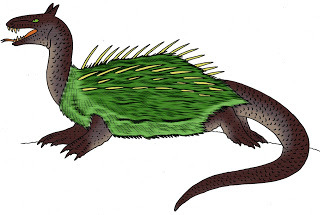 A second vivid artistic representation of the peluda (© Tim Morris)
A second vivid artistic representation of the peluda (© Tim Morris)More recently, however, the situation had become even worse, for the peluda had lately expanded its dietary scope - adding children and damsels to its murderous menu. Several of the village's fairest maidens had been devoured, and only this morning yet another had been ambushed and carried away - but this time she had not been alone. Her valiant fiancé had been nearby, and had witnessed the terrible deed. Now he swore vengeance against her antediluvian attacker, and he took up his trusty sword to do battle.
Protected from the peluda's deadly arsenal of self-propelling quills by his suit of mail, and additionally armed with knowledge gained from the village's wisest seer, the bold youth strode forth and aimed a terrible blow with his sword - but not at the monster's undulating neck, and not even at the heaving belly concealed beneath its shaggy fur. Instead, he hacked down at its writhing tail, and severed it in two with a single slash of his keen blade. Instantly, the mighty peluda keeled over and died - for its tail was the only portion of its body vulnerable to mortal injury.
Back in La Fert‚-Bernard there was great rejoicing, and the remains of the peluda were embalmed. As for its conqueror, he was acclaimed forever more as a hero, and rightly so - after all, he had achieved a feat that not even the Great Flood had been able to accomplish!
For plenty of other diverse dragons, be sure to check out both of my dragon books – Dragons: A Natural History , and Dragons in Zoology, Cryptozoology, and Culture .
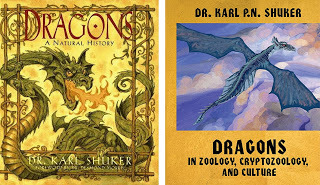
Published on September 05, 2015 09:11
Karl Shuker's Blog
- Karl Shuker's profile
- 45 followers
Karl Shuker isn't a Goodreads Author
(yet),
but they
do have a blog,
so here are some recent posts imported from
their feed.



